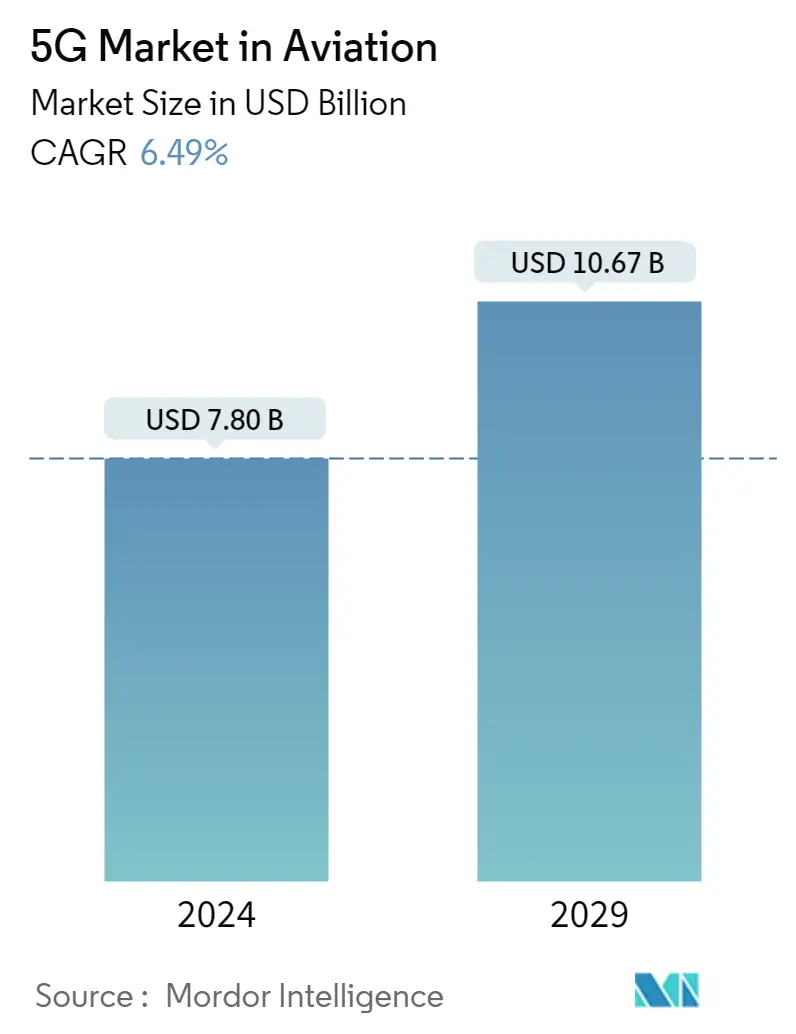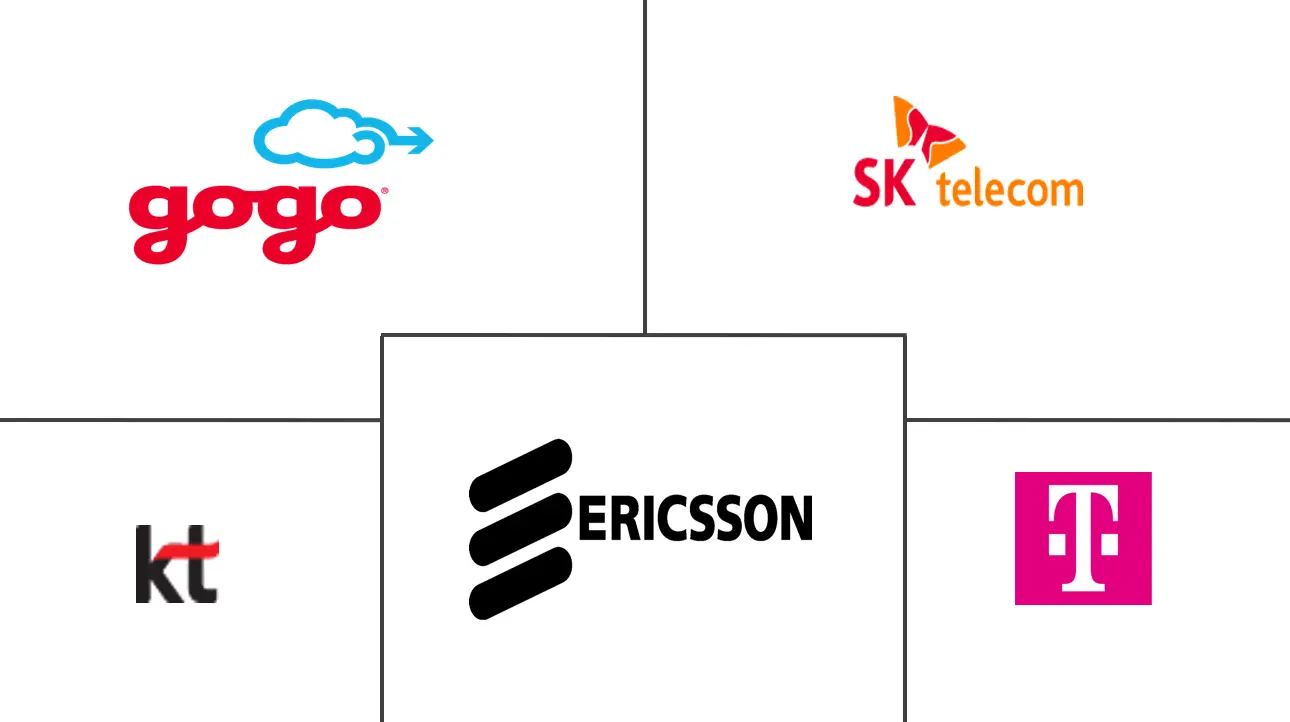Market Size of 5G Industry in Aviation

| Study Period | 2019 - 2029 |
| Market Size (2024) | USD 7.80 Billion |
| Market Size (2029) | USD 10.67 Billion |
| CAGR (2024 - 2029) | 6.49 % |
| Fastest Growing Market | Asia-Pacific |
| Largest Market | North America |
Major Players
*Disclaimer: Major Players sorted in no particular order |
5G in Aviation Market Analysis
The 5G Market in Aviation Industry is expected to grow from USD 7.80 billion in 2024 to USD 10.67 billion by 2029, at a CAGR of 6.49% during the forecast period (2024-2029).
The growing air passenger traffic, increasing application of connected technologies such as IoT in the aviation sector, and growing need for fast internet connectivity and better flight experience service are some of the factors driving the 5G market in aviation.
- 5G technology is one of the most invested technologies by many end-user industries in the global market. In the aviation industry, 5G is witnessing significant owing to a rise in passenger footfall, leading to a substantial rise in demand for more bandwidth and faster speed from passengers. Airline companies and other airport stakeholders are also seeking fast, seamless, and secure connectivity experiences for their essential technologies to enhance the passenger experience.
- The adoption of IoT is increasingly becoming part of the global digitalization trend in the aviation industry. The IoT network in such facilities requires a high-speed communication network, thus significantly boosting the demand for 5G in the aviation sector. For example, Schiphol in the Netherlands has about 70,000 sensors collecting real-time information on the performance of elevators and walkways. Wearables can also be used in an airport to drive efficiency. The Cincinnati/Northern Kentucky International Airport improved facility management using a solution that combines mobile devices, smart sensors, and a cellular network.
- Various industry associations are also further helping adopt the technology in the industry; one of the primary focuses currently is offering a better in-flight connected experience for customers. The Seamless Air Alliance has been formed by OneWeb (a global communications company), Airtel (an Indian Mobile Network Operator), GoGo (a company that works with airlines on in-flight broadband systems), and Sprint (a telecommunications company that delivers wireless services and is an internet service provider (ISP)); whereas the composition of the coalition is completed by Airbus and Delta Airlines.
- 5G connected Artificial Intelligence (AI) is expected to solve major pain points at airports, border checking, and other facilities in the industry. For instance, the technology can help match passengers to their bags as AI will be able to recognize unique scuff marks, creases, and material characteristics to distinguish between seemingly identical bags and match them to the correct passenger.
- Automating the airports and various facilities in such premises is increasingly becoming a reality due to higher communication speeds enabled by the 5G technology. Coupled with various advanced technologies such as AI and IoT, the 5G technology has made significant strides in aviation over the past few years. However, challenges such as 5G service could interfere with airplane altimeters, and safety issues in the aviation sector with 5G implementation may hamper the growth of the market.
- The COVID-19 pandemic resulted in a historical shift in the aviation industry while introducing new airport stakeholders' challenges. Public health measures raised amid the pandemic scenario worsened the bottlenecks in ground operations processes, adding up to the challenges that were already present in the pre-COVID era. However, new technologies, such as the deployment of 5G, offer ways to ease these operational constraints. The powerful features provided by a 5G network can also enable greater efficiency.
5G in Aviation Industry Segmentation
5G infrastructure and service providers are made part of the overall 5G market in aviation. Infrastructure providers include vendors offering mobile ultra-broadband networks supporting the future internet, whereas the service providers offer carrier networks facilitating end-user (aviation) specific applications. The scope of the research encompasses current market trends and dynamics by connectivity type segmentation and regional segmentation impacting the 5G market in Aviation. The assessment of the impact of COVID-19 on the 5G Market in Aviation has also been included in the study.
The 5G Market in Aviation is segmented by Connectivity Type (Ground-to-Ground Communication, Air-to-Ground Communication) and Geography (North America, Europe, Asia Pacific, Rest of the World).
The market sizes and forecasts are provided in terms of value (USD Billion) for all the above segments.
| Connectivity Type | |
| Ground-to-Ground Communication | |
| Air-to-Ground Communication |
| Geography | |
| North America | |
| Europe | |
| Asia-Pacific | |
| Rest of the World |
5G Market in Aviation Size Summary
The 5G market in the aviation industry is poised for significant growth, driven by the increasing demand for high-speed internet connectivity and enhanced passenger experiences. The integration of 5G technology is becoming crucial as air passenger traffic rises and the application of connected technologies like IoT expands within the sector. This technological advancement is not only aimed at improving in-flight connectivity but also at streamlining airport operations through automation and real-time data collection. The collaboration among industry stakeholders, such as the Seamless Air Alliance, underscores the collective effort to enhance in-flight experiences and operational efficiency. However, the implementation of 5G technology faces challenges, including potential interference with aircraft altimeters and safety concerns, which could impact its adoption in the aviation sector.
The North American region is expected to maintain a substantial market share due to its early adoption of advanced technologies and significant investments in connected aircraft and in-flight broadband. The presence of major industry players further supports market expansion in this region. Despite regulatory challenges, such as those posed by the FAA regarding 5G signal interference, the demand for high-bandwidth, low-latency networks continues to grow, driven by increased air traffic and modernization efforts in the aviation industry. Globally, airports are rapidly adopting 5G technology to improve ground-to-ground communication, with notable implementations like the Delhi Airport's 5G infrastructure. The competitive landscape of the 5G aviation market is characterized by both established and emerging players, with ongoing advancements in frequency bands and applications driving market dynamics.
5G Market in Aviation Market Size - Table of Contents
-
1. MARKET INSIGHTS
-
1.1 Market Overview
-
1.2 Industry Attractiveness - Porter's Five Forces Analysis
-
1.2.1 Bargaining Power of Suppliers
-
1.2.2 Bargaining Power of Consumers
-
1.2.3 Threat of New Entrants
-
1.2.4 Intensity of Competitive Rivalry
-
1.2.5 Threat of Substitutes
-
-
1.3 Assessment of Impact of COVID-19 on the Market
-
1.4 Technology Snapshot
-
1.5 5G in Aviation Use Cases
-
-
2. MARKET SEGMENTATION
-
2.1 Connectivity Type
-
2.1.1 Ground-to-Ground Communication
-
2.1.2 Air-to-Ground Communication
-
-
2.2 Geography
-
2.2.1 North America
-
2.2.2 Europe
-
2.2.3 Asia-Pacific
-
2.2.4 Rest of the World
-
-
5G Market in Aviation Market Size FAQs
How big is the Aviation 5G Market?
The Aviation 5G Market size is expected to reach USD 7.80 billion in 2024 and grow at a CAGR of 6.49% to reach USD 10.67 billion by 2029.
What is the current Aviation 5G Market size?
In 2024, the Aviation 5G Market size is expected to reach USD 7.80 billion.

